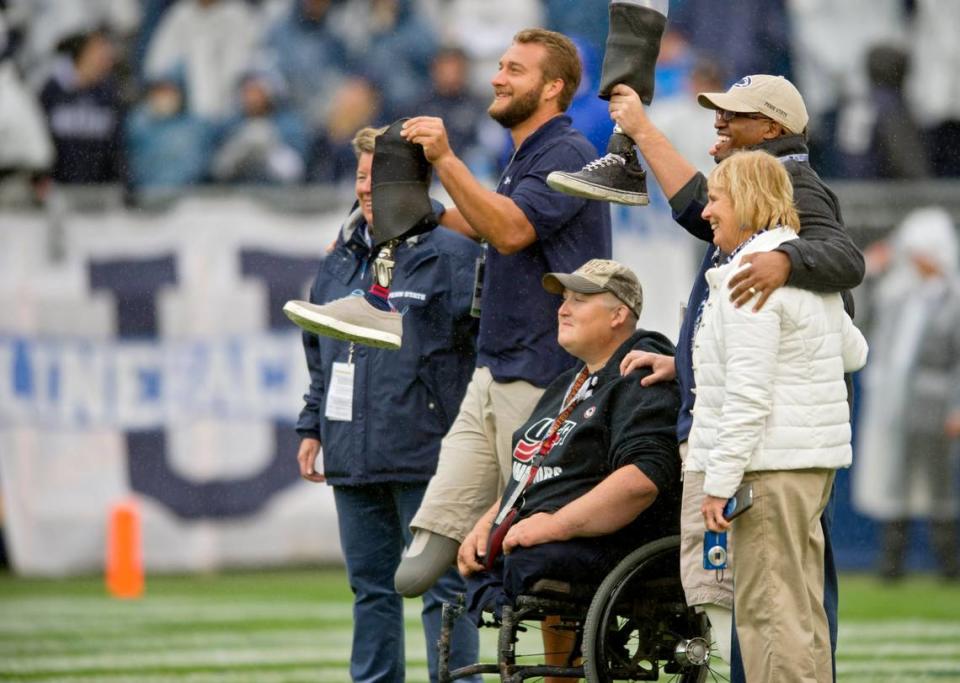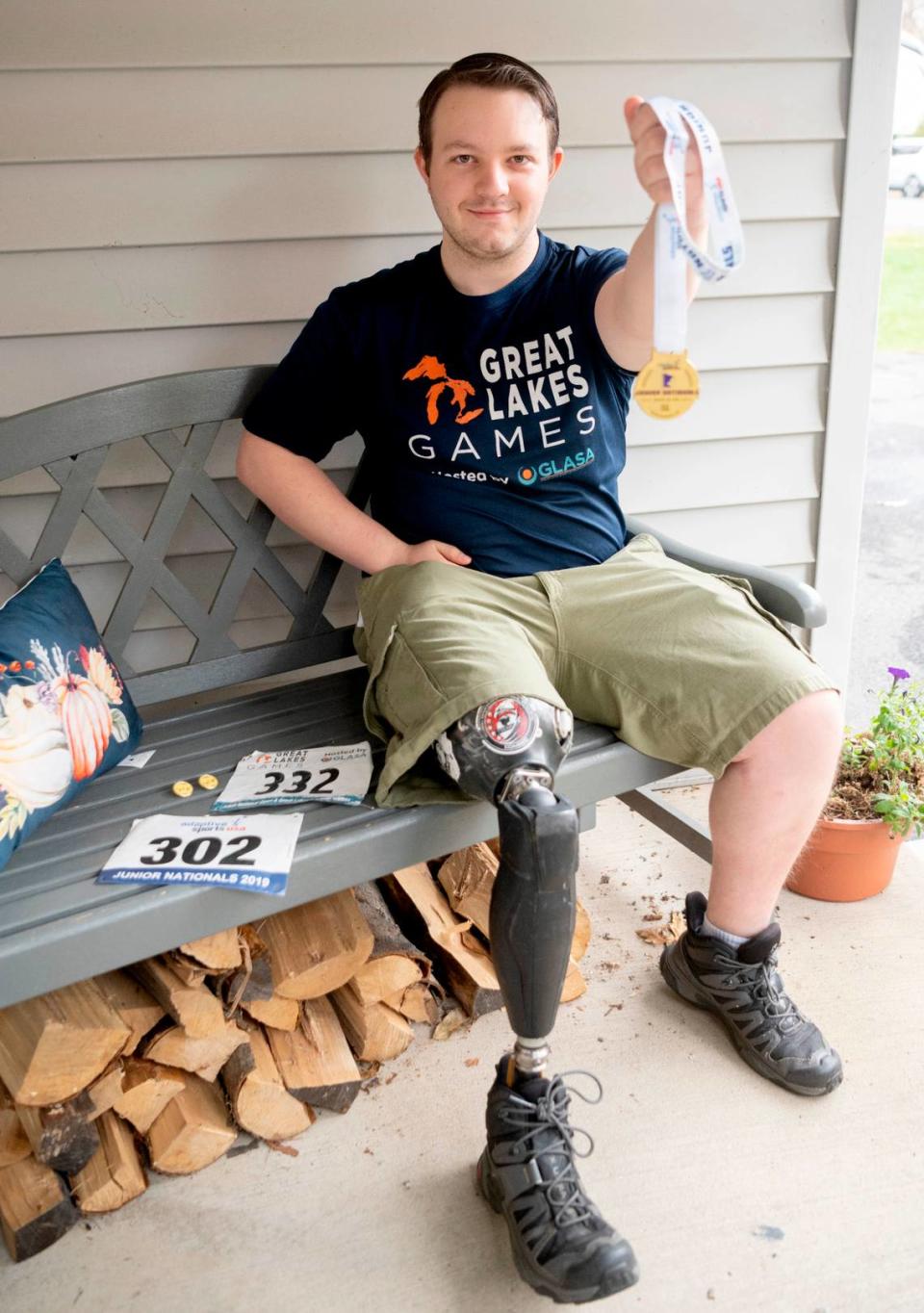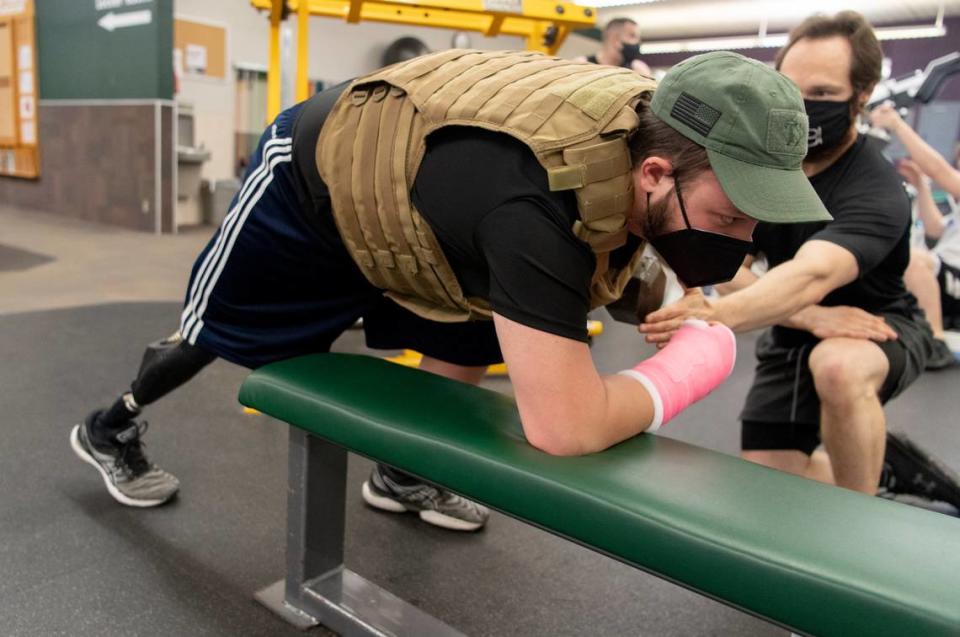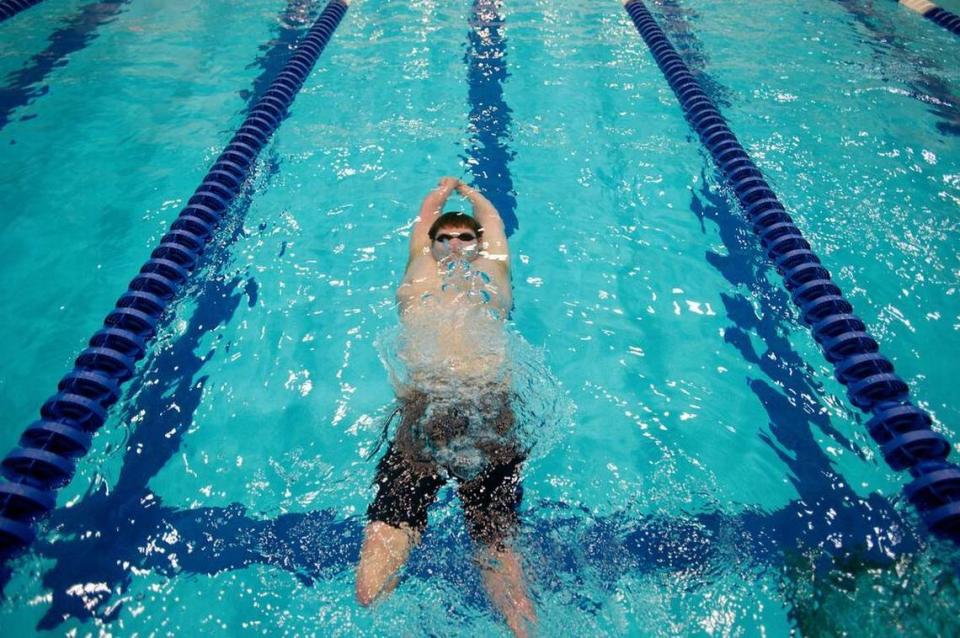PSU’s program for disabled athletes has been ‘paused’ for over 2 years. Supporters want answers
They’ve appeared in Nike commercials. They’ve represented Team USA in the Paralympic Games. They’ve had story after inspiring story written about their success, from disabled military veterans discovering a new love of sport to county-area athletes finding a talent they never knew they had.
But donors, student-athletes and former coaches for Penn State’s Ability Athletics program — created in 1999 for student-athletes with physical disabilities — are now worried those days might be over.
The university “paused” the program in March 2020 in the wake of the COVID-19 pandemic, a move thought to be only short-term. But, 33 months later, the program has still not resumed, forcing at least one student-athlete to find his own trainers and leaving him coachless without the ability to compete.
Supporters of the program have pressed the university for answers without much luck. But the issues run even deeper than a “pause.” Significant donors have been told, when the program does eventually resume, it will switch departments from Intercollegiate Athletics to Campus Recreation — which brings a whole new host of concerns that center on fairness, access and whether the program could even survive long-term.
“Penn State loves it when you get a gold medal and they write a story about you — they’ve done me a couple times — but that’s it,” said Penn State senior and State College native RJ Shirey, who lost his right leg in a hunting accident. “And once they use you and chew you up, they spit you back out. ... That’s unfortunately how it feels.”
As the “pause” continues, supporters of Ability Athletics are finding it harder to trust the intentions of the university. And for an institution that prides itself on diversity, equity, inclusion and belonging, the last few months have highlighted a series of broken promises and curious moves — the cancellation of a Center for Racial Justice, the inaction of police after a Proud Boys supporter pepper-sprayed on-campus protesters, lingering concerns about racial justice and now this.
“If there’s a will, there’s a way,” former Ability Athletics coach Teri Jordan said, specifically referring to her former program. “But you have to have the will.”

How we got here
Cracks in Penn State’s support of Ability Athletics began to appear even before the life-changing pandemic.
Teri Jordan, lauded as a pioneer of women in track and cross country, had long served as Ability Athletics’ coach. But she retired in the summer of 2019, after a 35-year Penn State career that included 20 years with Ability Athletics and 15 years with Penn State women’s track and field/cross country.
She was told then the program might transition to something more resembling a club sport, but she emphasized to officials that the program still needed support — access to varsity facilities and a coach — to thrive. As a well-respected coach herself, one who made the Olympics as an alternate in 1976, Jordan was well-connected to the Paralympics world. So in the months leading up to her retirement, she offered help in finding her replacement.
To her surprise, her offer was rebuffed.
“They basically told me to stay out of it and they had it all lined up,” Jordan recalled. “And, after a while, you quit asking.”
Months after her retirement, Ability Athletics still had no coach. Frustrated, Shirey and a teammate sat down with a senior associate athletic director and demanded a replacement. Shirey suggested Brian Buchkovich, a decorated sled hockey coach whom he had previously worked with.
Buchkovich was hired in November 2019 on a part-time basis. But he was taken off payroll less than six months later, by March or April 2020, when Penn State moved to remote learning as COVID-19 cases began to cascade. He assumed he’d return after the pause. So he felt the move was understandable. At least at first.
After all, the annual spring football scrimmage was canceled. March Madness was no more. Why should Ability Athletics be treated any differently? But by the fall of 2020, when nondisabled student-athletes resumed practice, Penn State still declined to restart Ability Athletics. Again, Buchkovich wondered, why should Ability Athletics be treated differently?
“When they started to add the able-bodied athletes back, that’s exactly the point where my athletes should have come back,” Buchkovich said. “And, in my opinion, it’s inexcusable they weren’t. They were excluded — and it’s a shame they were excluded.”
Because Ability Athletics’ student-athletes were not on scholarship, he was told, Penn State could not keep them in a “bubble” like the other athletes. Intercollegiate Athletics could not expect them to follow department directives or limit their exposure to COVID-19 while varsity athletes were tested at least weekly. That didn’t make much sense to Buchkovich, considering his two student-athletes never practiced at the same time as the nondisabled athletes, could have volunteered for testing and weren’t more susceptible to the virus.
Still, even as COVID and the associated dangers of the virus waned over the ensuing months and years, eliminating the need for a “bubble,” Ability Athletics remained inactive.

Shirey & the persisting ‘pause’
Shirey just wants to compete again — but, as a senior, he’s no longer sure if that’s possible.
Athletes without disabilities received an extra year of eligibility from the NCAA to make up for the pandemic. Shirey received ignored messages, at least two lost seasons and no space or equipment to even practice throwing a javelin or shot put.
During Shirey’s first serious competition in 2019, a tri-state meet with multiple competitors, his first javelin throw caused hushed murmurs from other participants. “How long have you been throwing?” the athlete behind him asked. “Four months,” RJ remembered telling him, laughing while recalling his surprised reaction.
In less than a full calendar year, Shirey went from virtually no experience to setting national records and earning gold medals at junior nationals in Minnesota for both the javelin and shot put. But after that national meet, once Jordan retired, the problems started. And just when it seemed as if brighter days were ahead, when Buchkovich became the new coach, COVID hit.
Suddenly, the world had bigger problems. Shirey worked on his own to stay in shape, remaining patient — up until COVID no longer made sense as an excuse. In fall 2021, Beaver Stadium resumed hosting crowds whose attendance outnumbered the population of all but three Pennsylvania cities.
“After that, I was like, listen, if they have these big football games with 100,000 people, there’s a problem,” he said. “Why is my program not back? Everything is back for us. What’s the problem? I reached out to a few people. Nothing.”
He couldn’t use varsity facilities. He couldn’t borrow javelins from the track and field team. He couldn’t visit athletic trainers if he had an injury. He couldn’t grab a free protein shake or snack pack, available to student-athletes in the varsity facilities. He didn’t have a coach.
He was on his own. Mostly, he still is.
He hired a local personal trainer, MBI Fitness, during the pandemic and paid out-of-pocket with help from friends. Eventually, this past June, he convinced Penn State to reimburse his training for about $6,000. He thought that might be a turning point, so he again tried reaching out to university officials.

Again, he came away largely disappointed. The vice president for educational equity, who helped him get reimbursed, didn’t return his messages. University President Neeli Bendapudi couldn’t find 10 minutes to meet with him. The athletics official who initially set up a call with him abruptly canceled — and then stopped returning messages altogether.
“If your football team can go to the Rose Bowl ... and they go all over the country all the time, and same with every other team,” Shirey said, “why are disabled athletes treated on a lesser scale? Why are able-bodied (athletes) getting treated differently than disabled athletes?”
University spokesperson Lisa Powers intimated that was not Penn State’s intent. She said, just as others did, that the pause started because of COVID-19. But it continued for several other reasons.
“Since then,” Powers said, “high turnover in leadership and staff, along with a decision to move it under the oversight of Student Affairs (Campus Recreation), have caused delays.” She also pointed to the fact Campus Recreation has a new director that was hired about two months ago.
The university did not offer specifics on when the program might resume, but it posted a job ad for a part-time coach Thursday. “Once a coach is hired, we can begin the process of restarting the program,” she wrote.
Upset donors & pressing questions
Penn State alum and mass communications consultant Todd Hilsee chose to create an endowment for Ability Athletics — one that currently stands at about $134,000 — because he wanted to make a difference for student-athletes who had long been overlooked.
He took pride in their success: Maggie Redden, who contracted polio as an infant and uses a wheelchair, represented Team USA in the 2008 Paralympic Games in Beijing. Rohan Murphy, who underwent a double leg amputation at 4 years old, was featured in Nike’s “No Excuses” commercials for his achievements with Penn State wrestling and Ability Athletics. Jake Schrom, whose right leg had to be amputated while working in landscaping, placed sixth in the 2020 Paralympic Games in Tokyo.

Multitudes of similar stories exist, from powerlifting to swimming to track and field. Hilsee celebrated them all. But he was also proud how Ability Athletics hosted weekly two-hour programs under Jordan — such as games of wheelchair basketball — to cater to all students with disabilities, casual athletes who weren’t eyeing international competition. (Buchkovich didn’t host those programs because he was told to focus on his athletes until summer 2020, when he could expand.) Hilsee didn’t see why Penn State would have cause to eliminate all that, so he took the university at its word when they initially “paused” operations.
But, as the weeks turned into months and the months into years, unanswered questions turned into doubts and doubts into anger.
“It’s a sad reality that, when someone is disabled, they have to live through a life of being told that, ‘Oh, well, you can’t do that. Because you’re disabled, you can’t do it,’” Hilsee said. “That’s why so few high-level disabled athletes simply exist in the universe. But that doesn’t have to be the case, and Penn State built a program to prove that.
“But now sitting here, sadly, there’s one senior athlete left because the program hasn’t been able to recruit. One senior athlete. That’s a shame — walking away from the potential for these kids instead of saying we’re proud and we’re going to do everything we can for them.”
When Penn State called looking for more donations in fall 2020, Hilsee pushed back. He wanted to know why the university wanted more money when it didn’t seem to be making use of his endowment. He wanted to know why Ability Athletics hadn’t been restarted and, unsatisfied with their answers, he eventually retained an attorney to ensure his endowment would be used as designed.
“I am not formally requesting that my funds be returned,” Hilsee clarified. “I want them to restart this program.”
When the program does resume operations, Hilsee and other donors are concerned whether it will survive, let alone thrive, under Campus Recreation. A university spokesperson acknowledged some exceptions would be made to the Campus Rec manual, putting some worries to rest, such as the minimum 10-member threshold that Ability Athletics likely cannot meet. But what about access to the varsity facilities? What about recruiting? What about this program’s future?
Supporters are worried about those answers because they wonder just how familiar current staff are with the program. This past fall, Shirey was even told Penn State couldn’t find a coach. (Buchkovich told the CDT he’s still available and would “love” to coach again, but no one has reached out.)
Penn State spokesperson Lisa Powers said Ability Athletics is still transitioning to Campus Recreation but, when completed, high-level athletes will receive support between a “collaborative effort” with Campus Rec and Intercollegiate Athletics. It’s not yet clear what that will exactly look like, but Powers said the intent is similar to before. She said the move to Campus Rec would also broaden the scope of the program.
“A change in the administration of the Ability Athletics program from ICA to Campus Recreation does not change Penn State’s commitment to ability athletes,” she said in a written statement, “and it will significantly enhance the sports and participation opportunities for all students.”
Importance, future of program
Ask a former member of Ability Athletics to describe the impact of the program, and most answers touch on the same theme — it was life-changing.
“I would be ashamed if it went away,” said Maggie Redden, a former Team USA Paralympian. “Because I know it meant so much to me and offered so much to me and really set me up. Because not only did I succeed in the program, but then I went on and that gave me that confidence to do a lot of other things.”
After Jake Schrom’s leg was crushed and amputated while he was a student at Penn State Mont Alto, he began Googling his athletic options when he stumbled upon Penn State’s Kortney Clemons, the first Iraq War veteran to qualify for the U.S. Paralympic team. He reached out to Ability Athletics’ coach, enrolled at University Park and eventually became a Paralympian himself in powerlifting.
But Ability Athletics did more than add a line to his resume. Schrom remembered his rock-bottom, how he went from being a strong individual to calling a nurse to roll him over so he could “go to the bathroom in a bucket.” Ability Athletics gave him the opportunity to meet people who could relate, people who could discuss a path forward.
“It helped get my confidence back, feel restored and get used to my new sense of self,” Schrom said. “Ability Athletics was very key in helping me kind of regain physical freedom and kind of help with my rehab along the way, because I was just learning how to walk again at that point. So that was very key in enriching my time at Penn State.”
Ability Athletics focused on the Olympic sports, as the program’s first coach was familiar with track and field. But if someone showed an interest elsewhere, Jordan found a way to adjust: Sean Brame, a quadriplegic amputee and Ability Athletics’ first swimmer, helped break an American paralympic record in 2018 in the 200-yard medley relay. Buchkovich, the second coach, was even looking into fencing and had plans for sled hockey.

Although Ability Athletics usually boasted athletes in the single digits, they proved flexible. If there was a year where participation was lower than usual, Jordan would focus on specialized weekly activities — like scuba diving. And there were always opportunities to recruit, whether it was during biannual clinics, weekly programs or certain meets, when high school student-athletes would compete alongside college athletes.
But, without a coach and with a program that’s still “paused,” there has been no recruiting. Shirey remembers a handful of student-athletes showing interest, but he doesn’t know what’s since happened to them. It’s just him now.
Supporters of the program don’t know where it’s headed. Even if Penn State resumes it tomorrow, how can they be sure that a university that put it on pause for 33 months would be committed to restoring it to what it once was? How can they trust a university that hasn’t involved them in any step of the transition to Campus Recreation?
“I wish I had the words to eloquently express my feelings, but I don’t,” Buchkovich said. “I wish I could make them understand how important this program is to the athletes, and to the school, for disabled students to have that option, that outlet, available to them. But they don’t.”
Shirey summed it up more succinctly.
“They don’t care.”

